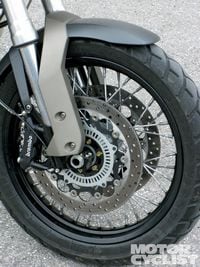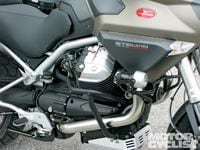Over the years, Moto Guzzi has developed a reputation as a conservative firm, renowned for producing unique machines that retain a traditional style and charm. Although set in their ways, you can't accuse Italy's oldest bike manufacturer of being slow to act or reluctant to listen to criticism. Not anymore, anyway.
Plenty of people who rode the 2009 Stelvio at its introduction last year commented on the bikes' flawed power delivery, and Guzzi's owners at the Piaggio Group listened. The Stelvio's 1151cc, eight-valve twin was unbalanced and peaky, with a feeble midrange and a sudden surge of top-end power. Not the kind of power delivery you want for an adventure bike, least of all a big Moto Guzzi.
Given the cold temperatures and occasional damp patches we encountered on our ride, I was also glad the new Stelvio comes equipped with ABS. The Brembo system's bite and feel were outstanding. And try as I might, repeated hard stops downhill couldn't provoke the ABS into getting overworked and losing stopping power, as various BMW systems have done in similar circumstances.
At $15,990, the Stelvio ABS is reasonably priced to compete against its adventure-touring rivals. It might not be the most sophisticated or powerful dual-purpose big twin, but it's a good-looking, versatile bike that is respectably quick, comfortable, sweet handling and well equipped. The 2010 Stelvio is proof that sometimes it really does pay to listen to your critics.
A year later, the Stelvio is back with a retuned engine. New camshafts, revised fuel-injection mapping and a larger-volume airbox broaden the motor's power and increase its versatility. In sharp contrast to the'09 bike, the 2010 Stelvio pulls effortlessly with the strong, low-rev grunt that has long been associated with Guzzi twins. The bottom-end hollow of the original Stelvio is gone, replaced by a pleasant, pulsating surge of torque that begins as soon as you release the clutch.
This is how a Moto Guzzi is supposed to feel!
The Stelvio's abundant, smooth power was wonderfully apparent as we headed into some steep, tight mountain roads. In traditional Guzzi fashion the big V-twin seemed to get smoother as the rpm rose, but there was no need to rev the motor. It was much more enjoyable to short-shift through the very precise six-speed gearbox, making the most of the engine's newfound flexibility and the traditional character of a big, booming V-twin.
Chassis layout is unchanged from the existing Stelvio. The stepped seat can be adjusted for height, to one of three positions. Presumably those are high, very high and sky-high, given that-despite being 6-foot-4-I struggled to climb aboard, and could only just get both feet down with the seat in the highest position. Shorter riders will inevitably struggle, though the adjustability is useful and the Stelvio is no taller than most of its rivals.
Once aboard, the Stelvio feels roomy and ready for the long haul with an easy reach to the slightly raised one-piece handlebar and fairly low-set pegs. The windscreen leaves a cocoon of still air, which is great because the Guzzi is plenty powerful to cruise at highway speeds. Adding optional touring accessories such as hand guards, saddlebags and heated grips should further increase its long-distance ability. Retained practical touches include the lockable fairing compartment, underseat storage, sturdy luggage rack and comprehensive, handlebar-operated instrument panel.
Handling is also impressive, which was just as well given the dizzying number of bends we had to navigate in a morning of continual climbs and descents. At a claimed 472 pounds dry the Stelvio is hardly a light bike. Much of that weight is carried high, and steering geometry is as conservative as you'd expect on an adventure bike. But I was impressed by how light the bike felt, and how easily and precisely it could be maneuvered with a gentle nudge of the wide handlebar.
Some of the Stelvio's quick handling can be attributed to its suspension. Despite having generous travel (6.7 inches up front and 6.1 at the rear) and being soft enough to float over cracked and undulating mountain roads, it is well-damped and resists wallowing. Even when the pace picked up, the Stelvio remained composed. The Pirelli Scorpion tires function well, aiding handling with their sporty profile and providing more than enough traction for the type of riding for which this machine is intended.
tech
Spec
Evolution
The latest iteration of Dr. John Wittner's eight-valve Daytona twin, retuned for use in a street-biased but off-road-worthy adventure-tourer.
Rivals
European adventure bikes such as the Benelli Tre1130K, BMW R1200GS and KTM 990 Adventure.
Verdict 3.5 stars out of 5
Significantly improved over last year's model, the Stelvio can now be considered a legitimate alternative to the German and Austrian adventure bikes.















/cloudfront-us-east-1.images.arcpublishing.com/octane/2WF3SCE3NFBQXLDNJM7KMXA45E.jpg)
/cloudfront-us-east-1.images.arcpublishing.com/octane/G4MG6OUCJNBSHIS2MVVOTPX65E.jpg)
/cloudfront-us-east-1.images.arcpublishing.com/octane/IIGGWFOTOJGB7DB6DGBXCCMTDY.jpg)
/cloudfront-us-east-1.images.arcpublishing.com/octane/QSTCM6AVEZA5JJBUXNIQ3DSOF4.jpg)
/cloudfront-us-east-1.images.arcpublishing.com/octane/U4I7G625B5DMLF2DVIJDFZVV6M.jpg)
/cloudfront-us-east-1.images.arcpublishing.com/octane/B6XD6LS6IVCQPIU6HXDJSM3FHY.jpg)
/cloudfront-us-east-1.images.arcpublishing.com/octane/ICL63FEDDRDTTMINYICCEYGMDA.jpg)
/cloudfront-us-east-1.images.arcpublishing.com/octane/FCGZHQXRBZFLBAPC5SDIQLVF4I.jpg)
/cloudfront-us-east-1.images.arcpublishing.com/octane/WNOB6LDOIFFHJKPSVIWDYUGOPM.jpg)

/cloudfront-us-east-1.images.arcpublishing.com/octane/X33NU3E525ECRHXLNUJN2FTRKI.jpg)
/cloudfront-us-east-1.images.arcpublishing.com/octane/6KKT5NNL2JAVBOXMZYS5ZO76YA.jpg)
/cloudfront-us-east-1.images.arcpublishing.com/octane/J5RKG5O455GMPGQRF2OG6LRT7A.jpg)
/cloudfront-us-east-1.images.arcpublishing.com/octane/GX2CIZKQVRH2TATDM26KFG2DAE.jpg)
/cloudfront-us-east-1.images.arcpublishing.com/octane/ZWIDYSAKQZHD5BHREMQILXJCGM.jpg)
/cloudfront-us-east-1.images.arcpublishing.com/octane/CYUHJZCTSJCH3MRAQEIKXK7SCQ.jpg)
/cloudfront-us-east-1.images.arcpublishing.com/octane/LKOFINY56FCXJCANJ5M7ZDQUBY.jpg)
/cloudfront-us-east-1.images.arcpublishing.com/octane/4NBPDACMWJH63JQYJVK3QRBDZI.jpg)
/cloudfront-us-east-1.images.arcpublishing.com/octane/KKHQHRR3FJGX7H2IPU6RALMWG4.jpg)

/cloudfront-us-east-1.images.arcpublishing.com/octane/5IOFS5JAE5FOXMNA23ZRAVVYUU.jpg)
/cloudfront-us-east-1.images.arcpublishing.com/octane/CGXQ3O2VVJF7PGTYR3QICTLDLM.jpg)

/cloudfront-us-east-1.images.arcpublishing.com/octane/OQVCJOABCFC5NBEF2KIGRCV3XA.jpg)